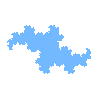


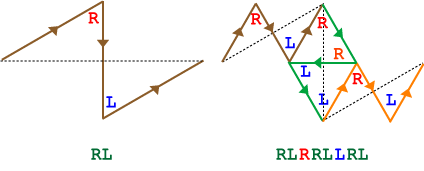
This construction can also be described by the following IFS:
|
\({f_1}({\bf{x}}) = \left[ {\begin{array}{*{20}{c}}
{1/2} & { - \sqrt 3 / 6} \\
{\sqrt 3 / 6} & {1/2} \\
\end{array}} \right]{\bf{x}}\) |
scale by \(1/ \sqrt 3\), rotate by 30° |
|
\({f_2}({\bf{x}}) = \left[ {\begin{array}{*{20}{c}}
{ 0} & { \sqrt 3 /3} \\
{-\sqrt 3 /3} & { 0} \\
\end{array}} \right]{\bf{x}} + \left[ {\begin{array}{*{20}{c}}
1/2 \\
\sqrt 3 / 6 \\
\end{array}} \right]\) |
scale by \(1/ \sqrt 3\), rotate by −90° |
|
\({f_1}({\bf{x}}) = \left[ {\begin{array}{*{20}{c}}
{1/2} & { - \sqrt 3 / 6} \\
{\sqrt 3 / 6} & {1/2} \\
\end{array}} \right]{\bf{x}}+ \left[ {\begin{array}{*{20}{c}}
1/2 \\
-\sqrt 3 / 6 \\
\end{array}} \right]\) |
scale by \(1/ \sqrt 3\), rotate by 30° |
Notice that in the iterations for \(T_1\) and \(T_2\) shown above, the sequence for \(T_{2}\) consists of three copies of the sequence for \(T_1\) (shown in green) separated by R and L, respectively.
This recursive pattern holds for all iterations since \[T_{n+1} = f_1(T_n) \cup f_2(T_n) \cup f_3(T_n)\] as depicted in the following image:

The first function in the iterated function system will just rotate \(T_n\) by 30° (which becomes the brown piece in the image above). This will not change the direction of the turn at each corner of \(T_n\), so the first part of \(T_{n+1}\) will have the same sequence of turns as \(T_n\). The second function in the IFS will rotate \(T_n\) by −90° (the green piece) and then translate so that the beginning of the green piece joins the end of the brown piece. The two pieces then form a new corner that has a right turn of 60°, so an R must be added to the end of the sequence from \(T_n\). The sequence of the turns in the second piece has not changed, however, so another copy of \(T_n\) follows that R. Finally, the third function will rotate \(T_n\) by 30° (which becomes the orange piece) and translates so that the beginning of the orange piece joins the end of the green piece. The second and third pieces form a new corner that has a left turn of 60°, so an L must be inserted. But again, the sequence of turns in the third piece has not changed so a final copy of \(T_n\) is added. (The IFS will also scale each piece, but this will not affect the direction of each turn.)
In their 1970 paper, Knuth and Davis expressed this relationship (with slightly different notation) as \(T_{n+1} = T_nRT_nLT_n\).
Since \(T_2\) = RLRRLLRL, we know that \(T_3\) must consist of three copies of this sequence separated by an R and L, respectively. So
\(T_3 = T_2RT_2LT_2\) = RLRRLLRL R RLRRLLRL L RLRRLLRL
The image below shows \(T_3\) with each segment colored either Red or bLue based on the sequence above. Following the curve starting at the black dot, each Red segment ends with a turn to the right, and each bLue segment ends with a turn to the left (the last segment is not part of the code, but is colored Red since in the next iteration there would be right turn at the end of this segment). Paying attention to the colors, can you trace the curve from end to end?
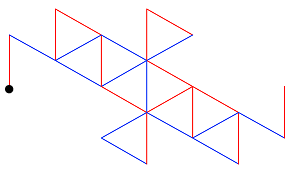
The curve can be traversed from the left endpoint to the right endpoint in such a way that the curve intersects only at corners and never crosses itself. [Demonstration with \(T_5\) and \(T_{7}\)]
Let the turns at the corners of \(T_n\) be denoted by \(a_i\) for \(1 \le i \le m\) and let the turns at the corners of \(T_{n+1}\) be denoted by \(b_i\) for \(1 \le i \le 3m+1\), where \(m=3^n-1\).
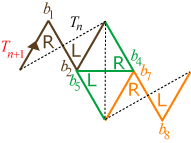
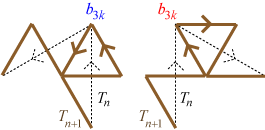
In the left image, each curve turns to the left at the common corner. In the right image, each curve turns to the right at the common corner.Therefore \(b_{3k}=a_k\) for \(1 \le k \le m\). We know, however, that \(T_{n+1}\) begins with \(T_n\) and therefore \(b_k = a_k\) for \(1 \le i \le m\). This means that \(b_{3k} = b_k\) for \(1 \le k \le m\).
These two observations provide an algorithm for how to generate the symbolic code for \(T_n\). First write out as many pairs of RL as needed, leaving a gap between each pair. Then fill in the gap at position 3k with the value at position k. For example, here is how it could be done for \(T_3\). Since \(3^3-1=26\), there are 9 pairs of RL separated by 8 gaps.
![]() Fill gap 3 with the value in position 1:
Fill gap 3 with the value in position 1:
![]() Fill gap 6 with the value in position 2:
Fill gap 6 with the value in position 2:
![]() Fill gap 9 with the value in position 3:
Fill gap 9 with the value in position 3:
![]() Fill gap 12 with the value in position 4:
Fill gap 12 with the value in position 4:
![]() Fill gap 15 with the value in position 5:
Fill gap 15 with the value in position 5:
![]() Fill gap 18 with the value in position 6:
Fill gap 18 with the value in position 6:
![]() Fill gap 21 with the value in position 7:
Fill gap 21 with the value in position 7:
![]() Fill gap 24 with the value in position 8:
Fill gap 24 with the value in position 8:
![]()
This is a convenient method to do by hand for small values of \(n\). For larger iterations, however, it is not difficult to write a short program to generate the code using the two observations above. [Python example]
Try it!
If \(r\) is not a multiple of 3, then \(k=r\) and \(m=0\). As shown above in method 2, the curve turns right if \(r \text { mod } 3 =1\) and turns left if \(r \text { mod } 3 = 2\).
If \(r\) is a multiple of 3, where \(r = k2^m\) and \(k\) is not a multiple of 3, then by the second observation in method 2, the direction of the turn at corner \(r\) is the same as the direction of the turn at corner \(k\) because you can keep dividing the corner number by 3 without changing the direction of the turn. But \(k\) is not a multiple of 3, so now the same argument as before applies to show that the direction of the turn at corner \(k\) is determined by the value of \(k \text{ mod } 3.\)
For example, in \(T_{10}\), which has 59048 corners, the direction at turn 4554 is L because \(4554=506 \cdot 3^2\) and \(506 \text{ mod } 3 = 2\).
Try it!
Position r =